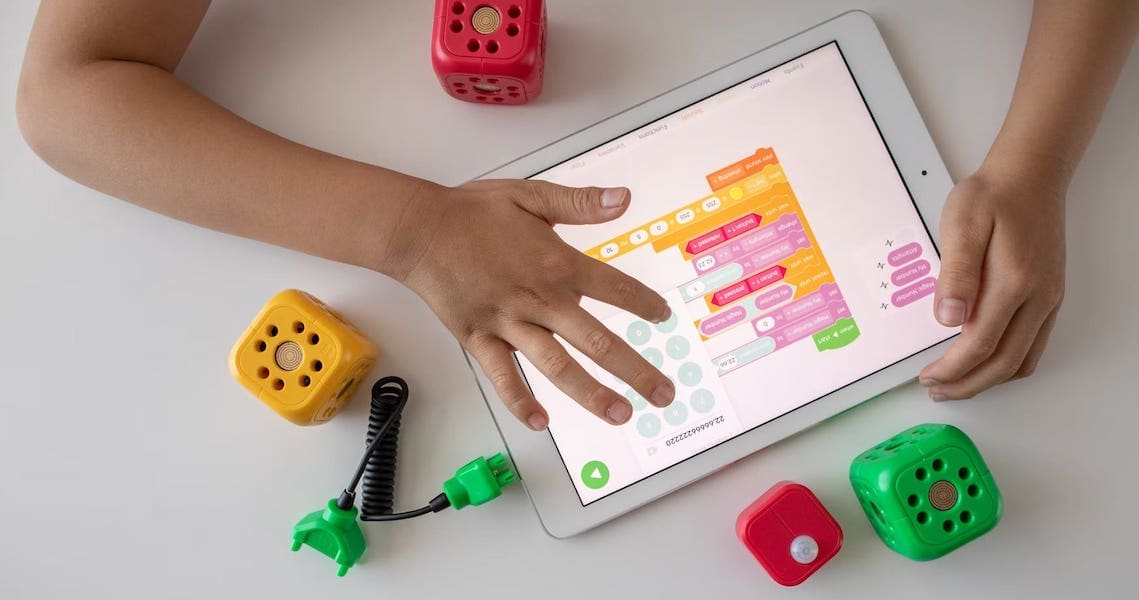
STEM (Science, Technology, Engineering, and Math) education is becoming increasingly important in schools. This is because STEM subjects are essential for a number of reasons, including preparing students for the workforce, fostering critical thinking skills, and promoting innovation and economic growth.
The tech industry, in particular, is growing rapidly and is in need of skilled workers. Schools can help students develop the skills and knowledge they need to succeed in this industry by teaching STEM subjects. In addition to the tech industry, many other industries also require workers with strong STEM skills, such as engineering, healthcare, and finance. In addition to preparing students for the workforce, STEM education can also help students develop critical thinking and problem-solving skills. STEM subjects require students to analyze data, develop hypotheses, and solve complex problems. These skills are not only valuable in the tech industry but also in many other fields. By teaching STEM subjects, schools can help students develop these skills, which can be useful throughout their lives.
Another reason why STEM education is important in schools is that it can promote innovation and economic growth. STEM subjects are essential for the development of new technologies and products, which can drive economic growth. By teaching STEM subjects, schools can help students develop the skills and knowledge they need to become innovators and entrepreneurs. This can help foster economic growth and improve the overall well-being of society.
The Benefits of Early STEM Education
STEM education should be started in schools as early as possible. This is because the concepts and principles underlying STEM subjects are best learned at a young age, when students are more receptive to new information and have a greater capacity for learning. By starting STEM education early, schools can help students develop a strong foundation in these subjects, which can benefit them throughout their academic careers and beyond.
In addition to starting STEM education early, schools should also provide students with a comprehensive and hands-on STEM curriculum. This means that schools should not only teach the core concepts and principles of STEM subjects, but also provide students with the opportunity to apply what they have learned through hands-on activities and projects. By providing a hands-on STEM curriculum, schools can help students develop a deeper understanding of these subjects and prepare them for success in the tech industry and other fields.
The Challenges of Adding Programming to a School’s Curriculum
Adding STEM, and particularly programming, to a school’s curriculum can be challenging. This is because STEM subjects, and particularly programming, require specialized knowledge and expertise. In addition, teaching programming can also require a significant amount of time and resources. As a result, adding STEM, and particularly programming, to a school’s curriculum can be a complex and time-consuming process.
On the other hand, learning to code can be a challenging but rewarding experience for students. But for many, the prospect of learning a new programming language and diving into complex technical concepts can be daunting. Fortunately, there is another option for students who want to learn coding without needing to write lines of code – no code platforms.
No Code and S.T.E.M.
A no-code platform is a type of software that allows users to create and build applications without writing code. Instead, users can use a visual interface and drag-and-drop tools to create and customize their apps.
Because no-code platforms are user-friendly and do not require any programming knowledge, they can be a valuable tool for teaching coding to beginners. By using a no-code platform, a teacher can provide students with a hands-on introduction to coding, allowing them to build and customize their apps without needing to learn complex programming languages.
In addition to providing a hands-on introduction to coding, a no-code platform can help students develop important skills, such as problem-solving, critical thinking, and creativity. These skills are essential for success in the tech industry, and by using a no-code platform, a teacher can help students develop these skills in a fun and engaging way.
How Can Students Learn to Code Using a No Code Platform?
School is not the only way for a student to learn to code. Nowadays, the Internet can benefit anyone who wants to learn how to code.
Here are some tips for students who are looking to learn to code using a no code platform:
- Start with the basics: Before diving into a no code platform, students need to understand the basics of coding. This includes understanding fundamental concepts like variables, data types, loops, and conditional statements. There are many online resources and tutorials available to help students learn these concepts, so take some time to brush up on the basics before getting started with a no code platform.
- Choose the right platform: There are many different no code platforms available, so it’s crucial for students to choose the one that is right for them. Some popular options include platforms like Webflow, Kodika.io, and Zapier. Each of these platforms has its own strengths and weaknesses, so do some research and choose the one that best fits your needs and learning style.
- Take advantage of tutorials and support resources: Most no code platforms come with a variety of tutorials and support resources to help users get started. Take advantage of these resources to learn the basics of the platform and start building your first applications.
- Experiment and play around: One of the best ways to learn is by doing, so don’t be afraid to experiment and play around with the no code platform. Try out different features and functions, and see what you can create. This will help you get a feel for how the platform works and what it can do.
- Join online communities and forums: There are many online communities and forums where students can connect with other users of the no code platform and share tips, advice, and resources. These communities can be a great resource for students who are just starting to learn to code, so consider joining one and participating in discussions.
Overall, using a no code platform is an excellent way for students to learn coding and develop their own software applications. With the right approach and the right tools, anyone can learn to code and create their own software, even without writing any code.
How a team of students can create a mobile app during a school project?
Creating a mobile app can be a challenging but rewarding project for a team of students. By working together, students can learn valuable skills and gain hands-on experience with app development.
Here are some steps that a team of students can follow to create a mobile app during a school project:
First, the team should come up with a good idea for a mobile app. This can be a fun and creative process, and the group should brainstorm different ideas and decide on the one that they think has the most potential.
Next, the team should create a detailed plan for the app. This should include a description of the app’s features and functionality and a timeline for development. The plan should also include a budget, as app development can be expensive, and the team must ensure they have enough resources to complete the project.
Once the team has a plan in place, they can begin working on the app. This will involve designing the app’s user interface, writing the code that makes it function, and testing the app to ensure it works properly. The team should work together and divide the work evenly so everyone can contribute to the project.
As the team works on the app, they should also keep track of their progress and make sure they are staying on track. This will involve regularly checking in with each other and making sure that everyone is meeting their deadlines. The team should also make sure that they are communicating effectively and working together seamlessly.
Finally, once the app is complete, the team should submit it for review and testing. This will involve submitting the app to Apple App Store and/or Google Play Store, where experts will review it and ensure it meets the necessary standards. If the app passes the review process, it will be made available to the public, and the team can be proud of the work they have done.
In conclusion, creating a mobile app can be a challenging but rewarding project for a team of students. By following these steps, a team of students can create a successful mobile app and gain valuable experience in app development.
What are some good Mobile App Ideas for a student to create?
There are many potential mobile app ideas that a student could create.
Some examples of good mobile app ideas for students include:
- A study app that helps students organize their notes, schedule, and assignments.
- A social networking app that connects students with other students at their school or in their area.
- A fitness app that provides users with workout routines and tracks their progress.
- A budgeting app that helps users track their expenses and manage their money.
- A language learning app that provides users with lessons and quizzes to help them learn a new language.
- A travel app that helps users plan their trips, book flights and hotels, and find things to do in their destination.
- A recipe app that provides users with a wide range of recipes and allows them to create their own recipe collections.
- A meditation app that provides users with guided meditation sessions and tracks their progress.
- A weather app that provides users with detailed weather forecasts and alerts for their area.
- A gaming app that allows users to play games and compete with other users for high scores and prizes.
Is it better to learn to code using a programming language or a no-code platform?
Whether it is better to learn to code using a programming language or a no code platform depends on the individual student and their goals.
Here are some factors to consider when deciding which approach is best for your school:
- If you want to have a deep understanding of how the software works and be able to create complex applications, learning a programming language is the better option. With a programming language, you will have full control over every aspect of your code, allowing you to create custom solutions to any problem you encounter.
- If you want to quickly create functional software without needing to write a lot of code, a no code platform may be the better option. No code platforms allow you to create applications using visual, drag-and-drop tools, making it possible for even non-technical users to develop functional software.
- If you are just starting out and are not sure if coding is right for you, a no code platform may be a good way to dip your toes in and see if you enjoy the process. This will allow you to create functional software without needing to invest a lot of time and effort into learning a programming language.
Kodika.io in Education
Are you a school or college looking to incorporate a no-code app builder into your curriculum? Look no further than Kodika.io! Many educational institutions are already using our platform to teach STEM and programming skills to their students. We offer education discounts to help make it more accessible to those in the education field. Contact us at team[at]kodika.io to learn more and discuss how Kodika can be integrated into your classes. Don’t miss out on this opportunity to give your students a valuable and cutting-edge learning experience.
